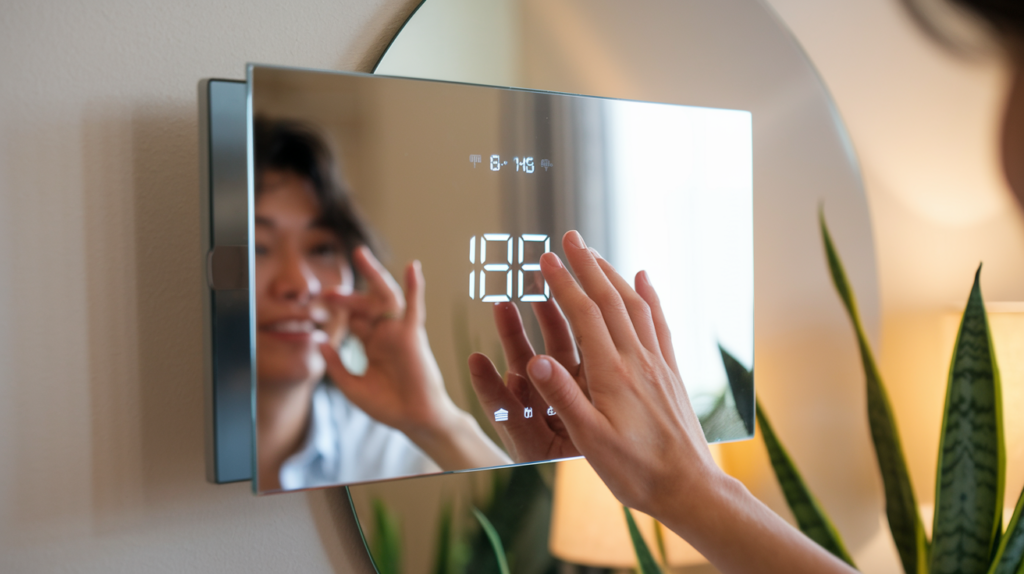Interactive mirrors, also known as digital smart mirrors, represent a significant innovation in the field of touchscreen technology. By seamlessly integrating touchscreen capabilities with reflective surfaces, these devices are revolutionizing how we interact with digital content. Interactive Smart Mirrors, which combine the functionality of traditional mirrors with advanced digital interfaces, offer a new level of interaction. This article explores the various ways interactive mirrors are utilized in touchscreen applications, their benefits, and their role in shaping future technologies.
Introduction to Interactive Smart Mirrors
Interactive smart mirrors are a cutting-edge advancement that merges the functionality of traditional mirrors with interactive digital technology. Unlike conventional mirrors, these devices feature embedded touch screens and sensors that enable users to engage with the mirror through touch gestures or voice commands. This integration transforms the mirror from a simple reflective surface into an interactive digital display.
For instance, in a retail setting, interactive smart mirrors allow customers to try on virtual outfits, view detailed product information, and even receive style recommendations—all directly from the mirror’s touch screen. This functionality not only enhances the shopping experience but also provides valuable insights for retailers looking to understand customer preferences and behavior.
Applications of Interactive Mirrors in Various Sectors
- Retail and Fashion: In the retail sector, interactive mirror can transform the way customers experience shopping. These mirrors can display virtual fitting rooms, allowing shoppers to see how different clothing items look on them without physically trying them on. This convenience reduces fitting room congestion and provides a more engaging shopping experience.
- Healthcare and Personal Care: Digital smart mirrors are also making waves in healthcare and personal care. These mirrors can display health metrics, track fitness progress, and offer personalized wellness advice. By integrating with other health-monitoring devices, they provide a comprehensive view of an individual’s health and wellness.
- Hospitality: In the hospitality industry, interactive mirror enhance guest experiences in hotel rooms and public spaces. Features like digital concierge services, interactive room controls, and local area information can be accessed through the mirror’s touch screen, adding a layer of convenience and personalization for guests.
- Home Automation: In smart homes, interactive mirrors serve as central control hubs. They allow users to manage home automation systems, adjust lighting, control climate settings, and interact with multimedia devices, all through a user-friendly touchscreen interface embedded within the mirror.
Advantages of Interactive Smart Mirrors
- Enhanced Interaction: Interactive mirrors provide a novel and engaging way for users to interact with digital content. Whether for personal use or in commercial settings, the touchscreen capabilities offer a unique experience that goes beyond traditional mirror functions.
- Versatility: These mirrors are highly versatile, finding applications across various industries. From virtual fitting rooms and health monitoring to hotel room controls and home automation, the functionality of digital mirrors extends far beyond simple reflection.
- Data Insights: In commercial environments, interactive smart mirrors equipped with touch screen technology can gather valuable data on user interactions and preferences. This data helps businesses tailor their offerings and make informed decisions to improve customer experiences.
Challenges of Implementing Interactive Mirrors
- Cost: The integration of touch screen technology into mirrors involves a significant investment. While the initial costs may be high, the potential benefits and return on investment often justify the expenditure.
- Technical Complexity: Developing and maintaining interactive smart mirrors requires sophisticated engineering and design. Ensuring reliable performance and seamless integration with other digital systems can be challenging.
- Privacy Concerns: With the collection of personal data through interactive mirrors, privacy and security become critical concerns. Implementing robust security measures and clear privacy policies is essential to protect user information and build trust.
The Future of Interactive Mirrors and Touchscreen Technology
Looking forward, the potential for interactive mirrors continues to expand. Future advancements may include improved display technologies, more responsive touch interfaces, and greater integration with other smart devices. These developments promise further to enhance the capabilities and appeal of interactive smart mirrors, making them an even more integral part of modern technology.
Transforming Touchscreens with Interactive Mirrors
Interactive mirrors are reshaping the landscape of touchscreen applications by combining reflective surfaces with advanced digital technology. Their ability to deliver interactive and engaging experiences across various sectors, from retail and healthcare to hospitality and home automation, demonstrates their versatility and impact. As technology evolves, interactive smart mirrors will play a crucial role in advancing touchscreen applications, offering innovative solutions for both personal and commercial use.
Stay tuned for more news and updates on Infinite Insight Hub!



